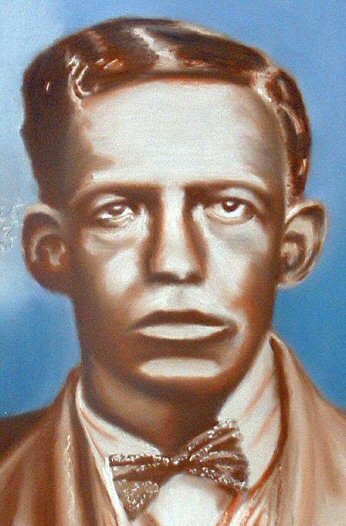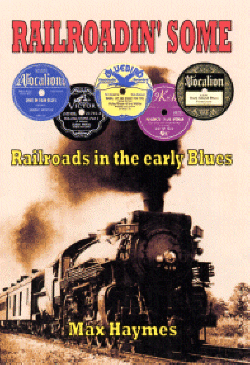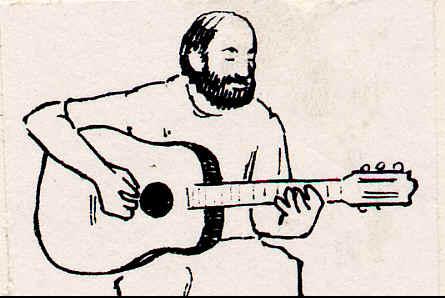
Painting © 2004 Loz
Arkle
Website
© Copyright 2000-2011 Alan White - All
Rights Reserved
Site optimised for Microsoft Internet Explorer



One Way / Country Rock Blues
by Max Haymes
Ever since the reissue of two titles on Origin in the early 1960s, by East Coast bluesman and sometimes barber William Moore, there has been speculation as to whether in fact these two sides featured the different “vocalists”. The titles were “Old Country Rock” (on OJL.2-”Really The Country Blues”) and “One Way Gal” (on OJL.8-”Country Blues Encores”). I use inverted commas for the word "vocalists" as one of the voices in purely spoken commentary. This appears on “Old Country Rock”. The commentator speaks at random points throughout with phrases such as “drop back folks an’ let your pappy rock, “ and “whip that box, Bill, whip it”. Intriguingly, the word ‘rock’ seems to be used, here at least, as a reference to dancing rather than making love! This voice is dark-sounding ‘with a heavy timbre which could not be obliterated except by perpetual use of a spoken falsetto.
“One Way Gal” on the other hand, lectures a high, clear vocal part to Moore’s deceptively simple and almost wistful guitar. It is obvious that the only guitar solo where this heavier voice is not present, is accompanied by comments from William/ Bill himself. On this title (“Ragtime Crazy”) the guitarist speaks when playing the least complex parts of his solo, which is quite logical, and does not address himself by name (a la Kokomo Arnold and his asides “ride ‘im, Koky, ride ‘im”, etc.). Whereas the commentator on “Rock” refers to "Bill" and on the other two sides where this person is present, as “old barber Moore”, “Uncle Bill”, “Barber Bill”, etc. This commentator also speaks during more complex guitar passages on “Rock” and remains silent on the more simple ones - in contrast to Moore's comments on “Ragtime Crazy”. I have no doubt that the singer on “One Way Gal” is also William Moore.
Godrich and Dixon agree that it is Moore who plays and sings on "Gall". They observed in 1982 that “It has been suggested that Bill Moore and William Moore are two different men, probably because the man on “One Way Gal” sings in a very high, almost falsetto voice. However, these titles are definitely all by the one artist.” (1). Two years later, Paul Oliver, by implication, believed Moore himself to be the commentator on “Rock” and the other three instrumentals. He refers to Moore talking "…lazily over the guitar in a low voice with marked cadences:” (2). In 1986, Bruce Bastin reports this speculation in his superb book “Red River Blues” (University of Illinois Press) but only cites the different names that Moore’s 8 sides were issued under, i.e. William and Bill Moore, as reason for this speculation. However, Godrich and Dixon’s statement does not tell the whole story.
Presumably at sometime in January, 1928 (or late Dec. 1927?) Moore, from Virginia, recorded 16 sides for the Paramount label in Chicago. While eight remain unissued, six were put out as by Bill Moore and two as by William Moore. It is with these 8 issued sides I am concerned.
Four feature vocal and guitar, "Barbershop Rag.’? being an instrumental track with spoken comments, and as already mentioned, so is “Ragtime Crazy". I will be returning to these soli in a moment. But first the four vocal cuts. Along with "Gal” both “Ragtime Millionaire” and “Midnight Blues” feature the same high voice; and it is blatantly obvious these are all by the one artist - Bill/William Moore. The fourth vocal outing (Paramount 12613), “Tillie Lee” seems to have been recorded with the lathe running a little too fast (80 r.p.m.?) but still points to the same singer as on the other three.
“Ragtime Crazy” which backed “One Way Gal” is a guitar solo with speech. The voice on this side is of the same high, near falsetto quality as Moore’s vocal tracks. So far, so good, however, “Barbershop Rag” is also a solo guitar effort with spoken comments (not a vocal as B. & G.R. stated) as Paul Oliver has noted (“Songsters & Saints”. P.44). On this title the voice has the heavier timbre of the commentator on “Old Country Rock”. The letter was issued on Paramount 12761 and was coupled with yet another solo outing with speech: “Raggin’ The Blues”. Once again the heavy-voiced commentator on “Rock” is present.
So the first alteration, as I see it, to Moore’s issued recordings in B.& G.R. should read:
‘William/Bill Moore gtr.; vo.- 1/speech or unk. male speech-3. c.January,1928.
One
Way Gal-1
Ragtime Crazy-2
Midnight Blues-1
Ragtime Millionaire-1
Tillie Lee-1
Barbershop Rag-3
Old Country Rock-3
Raggin’ The Blues-3
last two as William Moore.
The unknown commentator on the ‘-3’ tracks could be one of three possible candidates. At the end of Moore's session, in a footnote, Godrich and Dixon report that a copyright lead sheet was submitted by Chicago Music on 31 May, 1928 they comment “and it may be interesting to note that the William Moore coupling was credited to Moore and Williams”(3). Now it is reported that Moore, along with many other bluesmen, was influenced by Blind Blake at some early stage and one of the singers who worked with Blake in 1921 was Bill Williams “singing for road gangs near Bristol, TN,” (4). It is possible William Moore could have met Williams in Chicago while recording. Blake had a session c. November,1927 (or December?) and could have brought Williams with him. It would be nice, and convenient if Williams’ recordings for Blue Goose c.1970 confirmed that he was indeed the commentator on “Old Country Rock”, etc. However, even a cursory listen to Blue Goose 203 (“The Late Bill Williams”) soon dispels this theory. Bill, from Richmond, Virginia and long-time resident of Greenup, Ky. Sounds totally unlike Williams” the co-writer of “Old Country Rock”. Besides, Bill Williams had moved to Greenup by the time of the Moore session, and the co-writer would have had a vested interest (even if only an aesthetic one) to be in Paramount’s Chicago studio when William Moore recorded.
A second candidate could have been someone completely unknown to blues recordings who happened to be an acquaintance of Moore’s at the time.
But the third one seems a more likely possibility and once again involves Blind Blake. The next session this blues man recorded after Nov.'27 was c. April,1928 in Chicago, also of course for Paramount. Four sides were made and the first one was “Doggin’ Me Mama Blues”. On this song Blake was accompanied by an xylophone player, Jimmy Bertrand, who also provided spoken encouragement. The totally unrelated (to the Blues or Blind Blake’s voice and guitar!) playing of this instrument is hilarious to listen to. But it is Bertrand’s comments, or more correctly the way he says them which held my attention. His voice sounds virtually identical to the commentator on “Old Country Rock” and the other ‘-3’ tracks. Apart from recording for the same company, Birtrand was in the Paramount studio some 2 months after the William Moore session. However, he could easily have been in the recording room with Moore as he had moved from Mississippi to the Windy City and had “been working for some time with Erskine Tate’s Orchestra on State Street”.(5). Perhaps Tate’s outfit had already recorded that day and Bertrand had stayed behind or fallen asleep from too much booze! He certainly sounds like it, when he says: “Ah doggin' me--doggin’ me, sing 'em Mister Blake...stomp ‘em some more...Ah whip it--whip it to a cream gravy.” Bertrand speaks at random throughout “Doggin’ Me Mama Blues”, recalling the commentator on “Old Country Rock”. B.& G.R. list this blues by Blake as:
‘Doggin’ Me Mama Blues” Blind Blake (vo. gtr.); Jimmy Bertrand (speech,-xylophone). c. April ,1928. Chicago.
Desiring a second opinion. I got my younger brother, Rex (himself an accomplished blues guitarist) to sit and listen to the eight Moore sides as well as the Blind Blake/Jimmy Birtrand record. We are both of the opinion that there is a very strong case for the latter to be the commentator on Moore’s “Barbershop Rag”, “Raggin' The Blues” and “Old Country Rock”. So the revised personnel on “William Moore’s issued sides should now read:
‘William/Bill Moore gtr. vo.-1/speech-2; poss.? Williams or prob. Jimmy Bertrand
One Way Gal-1
Ragtime Crazy-2
Midnight Blues-1
Ragtime Millionaire-2
Tillie Lee-1
Barbershop Rag-3
Old Country Rock-3 as by William Moore
Raggin’ The Blues-2 as by William Moore.
B.& G.R. should be corrected accordingly.
Perhaps a jazz collector could throw more light on Bertrand’s recording sessions in 1928 with or without the Tate Orchestra. Maybe there are some early jazz sides featuring speech by Bertrand. Unfortunately the only other side I have by Blind Blake where Godrich and Dixon allocate the xylophone player a speech role, “Hot Potatoes” from the “Doggin’” session, just features Blake’s vocal and scat singing + his encouragement to Johnny Dodds to “play that thing” etc.
As a footnote, Bastin reproduces full list of Moore’s recorded legacy - all 16 titles. Interestingly, the only ones which bear the legend ‘melody’ in brackets, are the four is instrumentals already discussed; indicating that presumably, all his unissued material featured a vocal rather than a spoken commentary.
In closing I would like to thank my fellow countryman, Paul Swinton, for kindly supplying a cleaner version of “Tillie Lee” than was otherwise available, for the purpose of this article.
Notes
1.Godrich J.
& R.M.W. Dixon.n.548.
2.Oliver P.p.44
3.Godrich & Dixon. Ibid p549.
4.Harris S.p415
5.Oliver. Notes to LP
References
1.Godrich J.
& R.M.W. Dixon “Blues
& Gospel Records 1902—1943”.
3rd. Ed. Storyville 1982.
2.Oliver Paul “Songsters
& Saints”. Cambridge
Press. 1984.
3.Oliver Paul Notes
to “Blind Blake 1926-29 The
Remaining Titles". L.P.
Matchbox MSE 1003. c.1984.
4.Harris Sheldon. “Blues
Who’s Who”. Da Capo. 1979.
Copyright © 2000 Max Haymes. All rights reserved.




